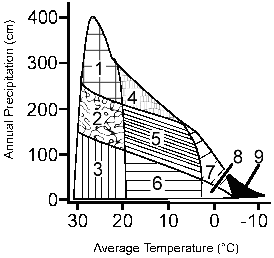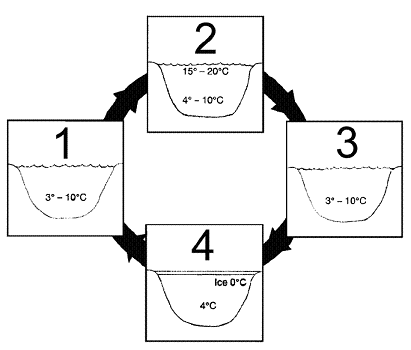Correct Answer

verified
Correct Answer
verified
Matching
Match the biome with its description.
Correct Answer
Matching
Match the aquatic ecosystem or zone with its description.
Correct Answer
Matching
Match the biome with its description.
Correct Answer
Multiple Choice
Figure 56-1

Based on the accompanying figure, what is the annual precipitation and temperature range for a temperate rain forest?
Based on the accompanying figure, what is the annual precipitation and temperature range for a temperate rain forest?
A) 300−400 cm/yr precipitation and 20−30 °C
B) 200−300 cm/yr precipitation and 20−30 °C
C) 200−300 cm/yr precipitation and 10−20 °C
D) 150−250 cm/yr precipitation and 10−20 °C
E) 150−250 cm/yr precipitation and 20−30 °C
Correct Answer

verified
Correct Answer
verified
Multiple Choice
Which biome has the greatest number of distinct layers of vegetation?
A) Savanna
B) Tropical rain forest
C) Desert
D) Chaparral
E) Grassland
Correct Answer

verified
Correct Answer
verified
Multiple Choice
Figure 56-2

Which of the lakes in the accompanying figure may experience turnover?
Which of the lakes in the accompanying figure may experience turnover?
A) 2 and 4
B) 2 and 3
C) 3 and 4
D) 1 and 2
E) 1 and 3
Correct Answer

verified
Correct Answer
verified
Multiple Choice
Climates characteristic of the Mediterranean region are also common in:
A) Nebraska.
B) New York.
C) Florida.
D) Hawaii.
E) California.
Correct Answer

verified
Correct Answer
verified
Matching
Match the biome with its description.
Correct Answer
Multiple Choice
Sponges and brittle stars are members of the ____ category of organisms:
A) nekton
B) phytoplankton
C) zooplankton
D) benthos
E) profundal zone
Correct Answer

verified
Correct Answer
verified
Multiple Choice
Based on the temperature range and precipitation, which area in the accompanying figure is dominated by pine trees?
A) 3
B) 4
C) 5
D) 6
E) 7
Correct Answer

verified
Correct Answer
verified
Multiple Choice
Microscopic algae typically fall under the classification of:
A) nekton.
B) phytoplankton.
C) zooplankton.
D) benthos.
E) profundal microorganisms.
Correct Answer

verified
Correct Answer
verified
True/False
Small lakes and ponds usually lack a profundal zone.
Correct Answer

verified
Correct Answer
verified
Multiple Choice
The tropical rain forest biome is characterized by:
A) high density of plants, but nutrient poor soil.
B) high density of plants and nutrient rich soil.
C) low density of plants due to nutrient poor soil.
D) low density of plants, yet nutrient rich soil.
E) intermediate density of plants and intermediate nutrient supply.
Correct Answer

verified
Correct Answer
verified
True/False
The hadal zone is that part of the benthic environment deeper than 6000 m.
Correct Answer

verified
Correct Answer
verified
Multiple Choice
Near the poles, what is generally the overriding climate factor?
A) Temperature
B) Precipitation
C) Latitude
D) Altitude
E) pH
Correct Answer

verified
Correct Answer
verified
True/False
The chaparral biome is characterized by grasses as high as 2 m.
Correct Answer

verified
Correct Answer
verified
Multiple Choice
There are no trees in the tundra because:
A) of the short growing season.
B) of the limited supply of nutrients in the soil.
C) of limited root penetration due to permafrost.
D) of limited precipitation.
E) of low temperatures.
Correct Answer

verified
Correct Answer
verified
Matching
Match the biome with its description.
Correct Answer
Matching
Match the aquatic ecosystem or zone with its description.
Correct Answer
Showing 41 - 60 of 99
Related Exams